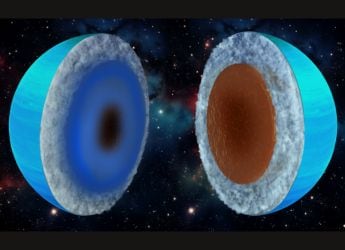- Home
- Science
- Science News
- Astronomers Calculate Mass of Milky Way Galaxy for First Time
Astronomers Calculate Mass of Milky Way Galaxy for First Time

Photo Credit: NASA, ESA and A. Feild (STScI)
Milky Way galaxy
Astronomers said Thursday they had accurately calculated the mass of the Milky Way for the first time, using new data sets that include the weight of dark matter.
In a collaboration between NASA and the European Space Agency's Gaia observation craft, a team of experts calculated our galaxy to be around 1.5 trillion solar masses.
Pervious estimates put the mass of the Milky Way ranging between 500 billion and 3 trillion times the mass of the Sun.
The uncertainty stemmed mainly from differing methods used to measure dark matter - which doesn't absorb or reflect any light and is thought to make up nearly 90 percent of matter in the Universe.
"We just can't detect dark matter directly," said Laura Watkins, from the Germany-based European Southern Observatory. "That's what leads to the present uncertainty in the Milky Way's mass - you can't measure accurately what you can't see."
To get around this, the team measured the velocity of globular clusters - dense groupings of stars that orbit the galaxy at enormous distances.
"The more massive a galaxy, the faster its clusters move under the pull of its gravity," said N. Wyn Evans, from the University of Cambridge's Institute of Astronomy.
"Most previous measurements have found the speed at which a cluster is approaching or receding from Earth, that is the velocity along our line of sight."
Instead, the researchers were able to use data collected by the Gaia probe and NASA's Hubble telescope to measure the sideways motion of clusters.
From this they could calculate their total velocity and from that their mass.
The Milky Way, the galaxy which contains Earth's solar system, is home to up to 400 billion stars and an estimated 100 billion planets.
Get your daily dose of tech news, reviews, and insights, in under 80 characters on Gadgets 360 Turbo. Connect with fellow tech lovers on our Forum. Follow us on X, Facebook, WhatsApp, Threads and Google News for instant updates. Catch all the action on our YouTube channel.
Related Stories
- Samsung Galaxy Unpacked 2025
- ChatGPT
- Redmi Note 14 Pro+
- iPhone 16
- Apple Vision Pro
- Oneplus 12
- OnePlus Nord CE 3 Lite 5G
- iPhone 13
- Xiaomi 14 Pro
- Oppo Find N3
- Tecno Spark Go (2023)
- Realme V30
- Best Phones Under 25000
- Samsung Galaxy S24 Series
- Cryptocurrency
- iQoo 12
- Samsung Galaxy S24 Ultra
- Giottus
- Samsung Galaxy Z Flip 5
- Apple 'Scary Fast'
- Housefull 5
- GoPro Hero 12 Black Review
- Invincible Season 2
- JioGlass
- HD Ready TV
- Laptop Under 50000
- Smartwatch Under 10000
- Latest Mobile Phones
- Compare Phones
- Redmi Note 15 5G
- Redmi Note 15 Pro 5G
- Redmi Note 15 Pro+ 5G
- Lava Play Max
- Poco C85 5G
- Honor Magic 8 Lite
- Jolla Phone
- Realme P4x 5G
- Asus ProArt P16
- MacBook Pro 14-inch (M5, 2025)
- OnePlus Pad Go 2
- Poco Pad M1
- Just Corseca Skywatch Pro
- Honor Watch X5
- Acerpure Nitro Z Series 100-inch QLED TV
- Samsung 43 Inch LED Ultra HD (4K) Smart TV (UA43UE81AFULXL)
- Asus ROG Ally
- Nintendo Switch Lite
- Haier 1.6 Ton 5 Star Inverter Split AC (HSU19G-MZAID5BN-INV)
- Haier 1.6 Ton 5 Star Inverter Split AC (HSU19G-MZAIM5BN-INV)

















